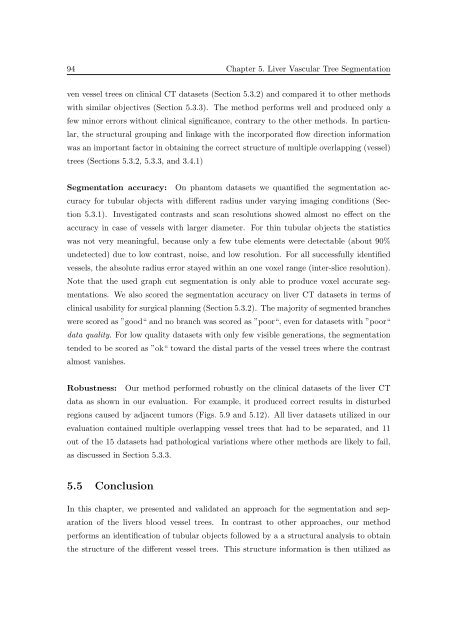Segmentation of 3D Tubular Tree Structures in Medical Images ...
Segmentation of 3D Tubular Tree Structures in Medical Images ...
Segmentation of 3D Tubular Tree Structures in Medical Images ...
Create successful ePaper yourself
Turn your PDF publications into a flip-book with our unique Google optimized e-Paper software.
94 Chapter 5. Liver Vascular <strong>Tree</strong> <strong>Segmentation</strong><br />
ven vessel trees on cl<strong>in</strong>ical CT datasets (Section 5.3.2) and compared it to other methods<br />
with similar objectives (Section 5.3.3). The method performs well and produced only a<br />
few m<strong>in</strong>or errors without cl<strong>in</strong>ical significance, contrary to the other methods. In particular,<br />
the structural group<strong>in</strong>g and l<strong>in</strong>kage with the <strong>in</strong>corporated flow direction <strong>in</strong>formation<br />
was an important factor <strong>in</strong> obta<strong>in</strong><strong>in</strong>g the correct structure <strong>of</strong> multiple overlapp<strong>in</strong>g (vessel)<br />
trees (Sections 5.3.2, 5.3.3, and 3.4.1)<br />
<strong>Segmentation</strong> accuracy: On phantom datasets we quantified the segmentation accuracy<br />
for tubular objects with different radius under vary<strong>in</strong>g imag<strong>in</strong>g conditions (Section<br />
5.3.1). Investigated contrasts and scan resolutions showed almost no effect on the<br />
accuracy <strong>in</strong> case <strong>of</strong> vessels with larger diameter. For th<strong>in</strong> tubular objects the statistics<br />
was not very mean<strong>in</strong>gful, because only a few tube elements were detectable (about 90%<br />
undetected) due to low contrast, noise, and low resolution. For all successfully identified<br />
vessels, the absolute radius error stayed with<strong>in</strong> an one voxel range (<strong>in</strong>ter-slice resolution).<br />
Note that the used graph cut segmentation is only able to produce voxel accurate segmentations.<br />
We also scored the segmentation accuracy on liver CT datasets <strong>in</strong> terms <strong>of</strong><br />
cl<strong>in</strong>ical usability for surgical plann<strong>in</strong>g (Section 5.3.2). The majority <strong>of</strong> segmented branches<br />
were scored as ”good“ and no branch was scored as ”poor“, even for datasets with ”poor“<br />
data quality. For low quality datasets with only few visible generations, the segmentation<br />
tended to be scored as ”ok“ toward the distal parts <strong>of</strong> the vessel trees where the contrast<br />
almost vanishes.<br />
Robustness: Our method performed robustly on the cl<strong>in</strong>ical datasets <strong>of</strong> the liver CT<br />
data as shown <strong>in</strong> our evaluation. For example, it produced correct results <strong>in</strong> disturbed<br />
regions caused by adjacent tumors (Figs. 5.9 and 5.12). All liver datasets utilized <strong>in</strong> our<br />
evaluation conta<strong>in</strong>ed multiple overlapp<strong>in</strong>g vessel trees that had to be separated, and 11<br />
out <strong>of</strong> the 15 datasets had pathological variations where other methods are likely to fail,<br />
as discussed <strong>in</strong> Section 5.3.3.<br />
5.5 Conclusion<br />
In this chapter, we presented and validated an approach for the segmentation and separation<br />
<strong>of</strong> the livers blood vessel trees. In contrast to other approaches, our method<br />
performs an identification <strong>of</strong> tubular objects followed by a a structural analysis to obta<strong>in</strong><br />
the structure <strong>of</strong> the different vessel trees. This structure <strong>in</strong>formation is then utilized as















